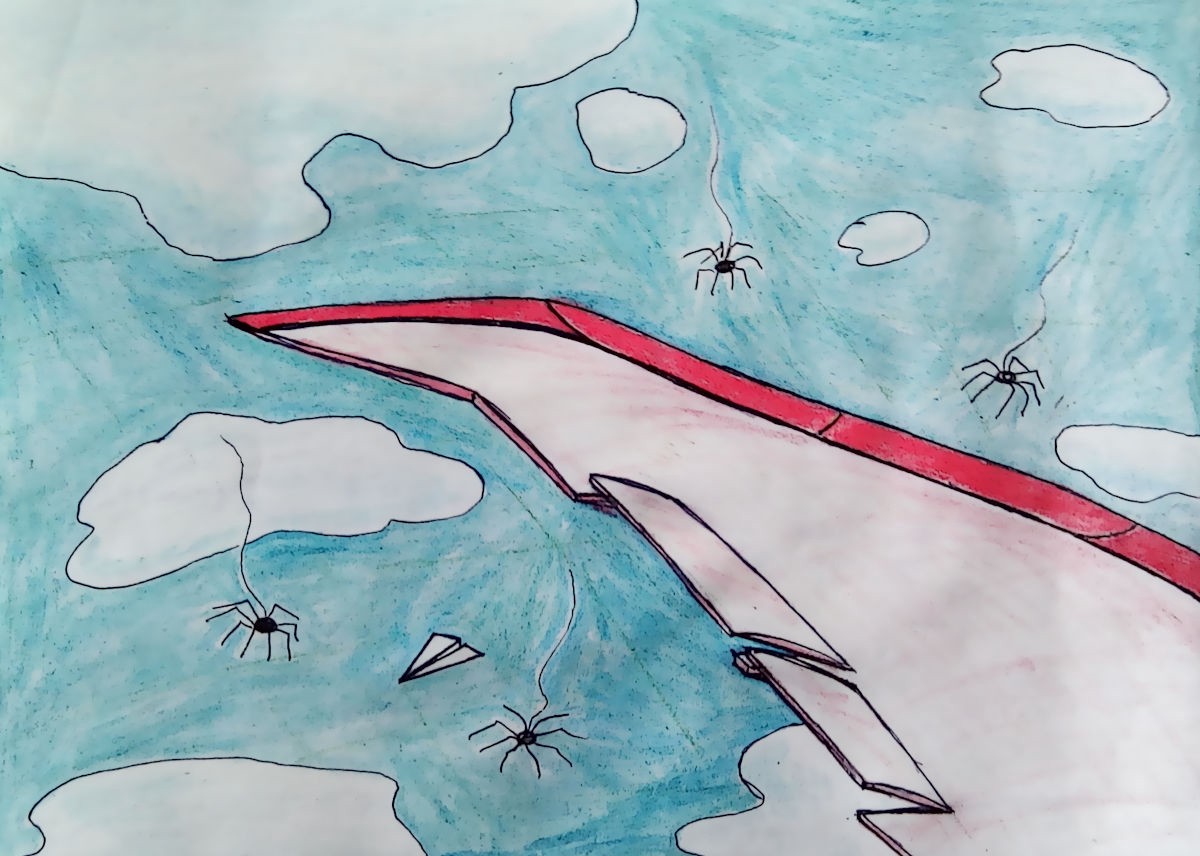Upward Forces
How the heck do planes fly? And, what weird ways do non plane-flying creatures use?

How the heck do planes fly? And, what weird ways do non plane-flying creatures use?
Airplanes. Aeroplanes. Oh God, let’s save that debate for another day, I’m Irish, so I call them aeroplanes, and sorry, you’re just going to have to deal with that.
It’s something every child has wondered. How does this weirdly shaped airbus transport me to the Costa del Sol, hair-braided, ice-pop in hand every summer? However, most people learn as they grow older how things like this work. I, on the other hand, have not.
I’ve decided to start a series dedicated to self-improvement. Somehow, I have managed to maintain a blissful ignorance on some of the most basic facts of life until the ripe age of 17. Because of this, I would make a dangerous adult, both to myself and others. I am actually quite proud of myself for acting on this unusual burst of self-awareness. I hope that you, as a reader, will join me on my journey of addressing the things I don’t understand.
I’ve been on a plane many times. Twice, if not three times a year, since the age of about 4. That’s almost 39 flights in my life and yet I’m still clueless as to how this aluminium cylinder flings me from Dublin to anywhere I want to go. Maybe it’s because I’ve had a sheltered upbringing, living in rural Ireland, where I didn’t really have to worry about anything ever. Or perhaps it’s because I simply don’t care.
I enjoy flights actually. Download a couple of good films, pop your headphones on and you’re sorted. Well, all that is about to change, my friends, we are not ignorant anymore!
Where does one go when one wants to learn something? Google. So that’s the first place I went. I simply typed “how do planes fly” into the searchbar. Explain That Stuff was the first website to flash onto my cracked iPad screen in front of me. It said,
“A plane’s engines are designed to move it forward at high speed. That makes air flow rapidly over the wings, which throw the air down toward the ground, generating an upward force called lift that overcomes the plane’s weight and holds it in the sky. The wings force the air downward and that pushes the plane upward.”
OK, um, what? Firstly, what on earth do they mean by the wings “throwing the air down”? And secondly, what is this mysterious unseen force that just holds the plane in the sky?
Let’s look into how this force called ‘lift’ actually works. Is it unique to aeroplanes, for instance? Surely things like birds and bats use it?
Apparently, a bird’s wing produces lift during the thrust and downfall. See, that makes sense, as birds flap their wings. When they flap down and push down on the air, the air in turn pushes them up. But I don’t think planes flap their wings.
In living things, ‘lift’ is produced by moving the wing at speed through the air. In most living things, that is. Unfortunately, just when I thought I’d got things in order, I came across a type of spider that uses an electric field to take off into the air. As if flying spiders weren’t scary enough already, they have to be wizards too.
Hard as I tried to ignore this new discovery in my research, I decided that, if I had to suffer through learning this, then so should you.
These creepy spiders will climb to an exposed point, raise their abdomens to the sky, send out strands of silk, and…float away. I’m shuddering as I’m writing this. I can genuinely feel tears forming.
This behaviour is actually called ‘ballooning’, and might carry spiders away from predators or towards land with more abundant resources. They have been found two-and-a-half miles up in the air, and 1,000 miles out to sea! Darwin himself found the rapidity of spiders’ flight to be “quite unaccountable” and its cause to be “inexplicable.”
If it’s not lift or air pressure, then what is it?
Here’s what I gathered. Every day, around 40,000 thunderstorms crackle around the world, collectively turning Earth’s atmosphere into a giant electrical circuit. The upper reaches of the atmosphere have a positive charge, and the planet’s surface has a negative one. Even on sunny days with cloudless skies, the air carries a voltage of around 100 volts for every meter above the ground. In foggy or stormy conditions, that gradient might increase to tens of thousands of volts per meter.
Ballooning spiders operate within this planetary electric field. When their silk leaves their bodies, it typically picks up a negative charge. This repels the similar negative charges on the surfaces on which the spiders sit, creating enough force to lift them into the air. And spiders can increase those forces by climbing onto twigs, leaves, or blades of grass. So there’s that.
In case you haven’t noticed, I really don’t like this idea. I prefer to believe in the magic of ‘lift’ and think of sparrows and planes soaring through the air, not spiders floating on electric currents.
In order to help myself forget about ballooning spiders, I decided to put a good old-fashioned paper plane to the test. Flinging the paper plane into the air, actually did help me to grasp the idea.
When you throw up a paper plane, gravity obviously tries to pull it down. However, this movement also causes a difference in the air pressure on the wings, which can then generate lift. Air moves faster on top of the wings than it does at the bottom, and that’s what creates the pressure difference.
Fantastic! Now I can visualise this movement, I just need to get the technical bit into my head.
Now, I know that this is not the best explanation you will ever read on how planes fly, but in my opinion, and — albeit, limited — experience, you can never be 100% correct in your explanation, but you can be 100% wrong. And this piece is not 100% wrong!
I finished my second-last year of secondary school at the end of May, and I’ve been feeling like a bit of a slug ever since. So if trying to learn and then badly explaining to readers on a global writing platform how planes fly is what it takes to make me feel productive, I’ll do it. I was supposed to be at a music festival this weekend, so this is a nice distraction from the light depression I’ve been dealing with by solely through scrolling TikTok and listening to One Direction’s entire discography all day. In fact, I’m sitting here with a cup of coffee, hair in a bun, at my desk (I know, wow) and feeling great.
With that out of the way, let’s move forward.
My next move was to search up “how do planes fly for kids”. It really took a lot out of me to type that. Demoralising, in a way. Moving swiftly on, ct.gov was able to tell me the following;
“Airplanes fly because they are able to generate a force called Lift which normally moves the airplane upward. Lift is generated by the forward motion of the airplane through the air. This motion is produced by the Thrust of the engine.”
Also, it turns out that a real plane’s wing is curved at the top. So when it runs into the air, some air goes over the top and some goes underneath. Faster air reduces pressure, and, with less pressure on top, the plane gets pushed forward.
OK, so if ‘fast-moving air pressure on top of the wings’ is what keeps a plane in the air, then I can understand how the engine of the plane would thrust it forward, all these different elements combined giving you that nervous excitement in your chest as you take off 35,000 feet above the ground in a tin cylinder gunning for a tropical resort or a city break.
Here’s the thing: aeroplanes are complicated. Obviously. The fact is that the physics of flight isn’t trivial, nor is it easy to understand. But at least now I can go forward into my adult life without flying high in a plane and wondering how on earth I got there, or even worse, not caring.
If you ask me, a bit of curiosity is the essence of life. If we didn’t have it, we’d never explore, and certainly never publish or read articles on a platform like Medium.
Wow. This little project has really got me thinking that maybe everyone doesn’t know as much as they let on. There’s a huge amount of pretending that we all do in life. My mam always told me “fake it till you make it”. But as you can see, I’ve decided to take the complete opposite approach and try to educate myself on a few of the basics. I still barely know how planes work, but that’s OK. Because maybe it’s more exciting to have a little magic in our lives. Maybe ignorance really is bliss, and maybe I should hold on to my sense of childhood wonder.
That magical force called “Lift” is what allows me to explore, brings me to places where I can experience different cultures and ways of life.
Did you like this piece? Stay tuned for the next instalment where I tackle the notion of internet “clouds”!
